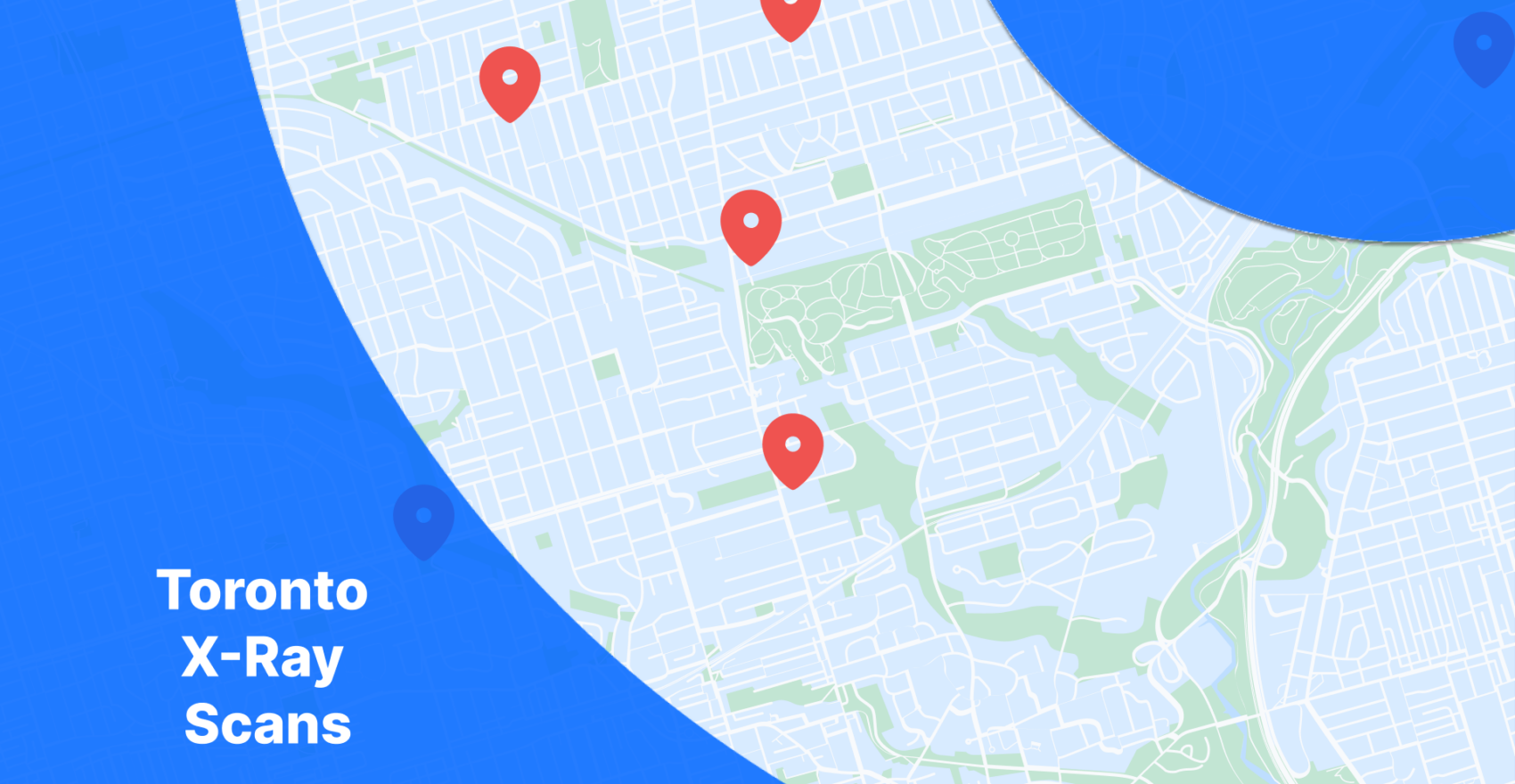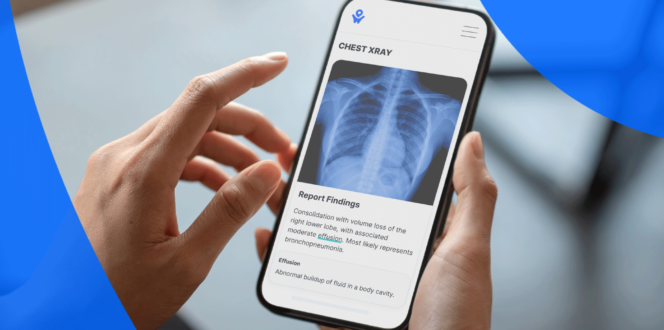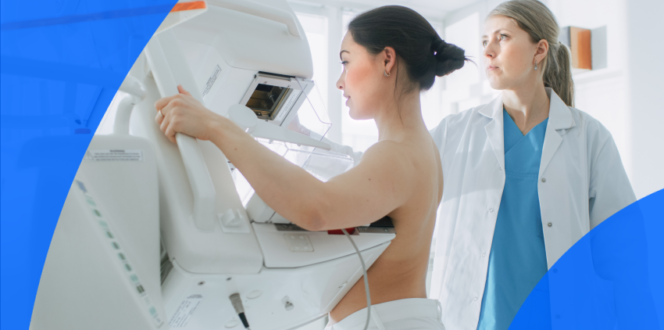Getting an X-Ray in Toronto? Where to Go and What to Know

If you’re booking an X-ray in Toronto, here’s the information you need to find a clinic, avoid long wait times and get your results faster.
A medical X-ray uses low-dose electromagnetic radiation to create images of the internal structures of your body. Painless and non-invasive, X-rays provide valuable information to help doctors diagnose and monitor the treatment of illnesses and injuries.
If you live in Toronto or the GTA, this post will let you know:
- Why you might need an X-ray
- Where you can get an X-ray in Toronto
- How to prepare for your X-ray
- How quickly you can get your results
Why get an X-ray?
Your doctor might refer you to book an X-ray to help diagnose or monitor a variety of conditions, illnesses or injuries. The body part you have X-rayed will depend entirely on the symptoms you show. For instance, you might receive a:
- Chest X-ray if you show signs of bronchitis or pneumonia.
- Bone X-ray if you have a potential break or fracture in any bone.
- Abdominal X-ray to diagnose kidney stones, gall bladder issues or other abdominal blockages.
- Mammogram, a specialized type of X-ray, to evaluate any breast abnormalities, or as a regular screening exam.
- DXA (Dual X-ray Absorptiometry) scan, also known as bone densitometry tests to measure the mineral density of your bones.
Although very low-dose, X-rays do emit radiation, so it is often best to avoid them if you are pregnant.
When to get an ultrasound over an X-ray?
Both X-rays and ultrasounds provide detailed internal images that help doctors diagnose or monitor medical conditions. Ultrasounds use sound waves, while X-rays use electromagnetic radiation. Because ultrasounds do not use radiation, they are a good choice for prenatal images.
X-rays have a higher penetrative capability than ultrasounds, particularly when it comes to the hard structures of the body. They are often used to examine bone and areas where bone structures might present an imaging obstacle (e.g. ribs in the chest, etc.). Conversely, ultrasounds are often used to provide images of internal soft tissues and organs.
Where to get an X-ray in Toronto
If your doctor refers you for an X-ray, you will need to book the appointment yourself. Your referring physician will provide you with a requisition which you can use to make an appointment with an imaging clinic. Unless you have a serious issue or are already admitted, you’re not likely to book your X-ray at a hospital.
Instead, you’ll need to find an imaging clinic near you. Sometimes your doctor will have recommendations for clinics in your area. Some imaging clinics provide walk-in services, but they are not always available for every type of X-ray. To avoid long wait times, it’s best to book your X-ray in advance whenever possible.
In Toronto and the GTA, there are many imaging clinics, some with multiple branches, providing X-rays of all types. Here’s a partial list:
- Bluewater Imaging
- Dixie X-Ray Associates
- EXR Medical Imaging
- GAM Diagnostic Imaging
- Humber Valley Imaging
- Insight Diagnostic Imaging
- KMH Cardiology Centres
- Premier Diagnostic Network
- True North Imaging
- Valence Medical Imaging
- WELL Health Diagnostic Centres
- Wentworth-Halton X-Ray and Ultrasound
You can also book X-rays without a requisition through a private imaging clinic, but you will have to pay for it out of pocket, which can be expensive.
How long does it take to get an X-ray appointment?
Depending on what type of X-ray you need and which imaging clinic you choose, you can often book an X-ray very quickly. Some clinics even offer walk-in services, which means you can get your X-ray during your visit. However, when it comes to specialized X-rays, like mammogram scans, you might wait several weeks.
You can often decrease any waiting period by traveling to another clinic location, by choosing an off-peak time or by agreeing to be waitlisted for last-minute cancellations.
How much does it cost to get an X-ray in Toronto?
In Toronto and the GTA, OHIP covers the cost of a medical X-ray if:
- It has been deemed medically necessary
- Your doctor provided a requisition
Dental X-rays are not covered by OHIP.
If you have an immediate concern, or if a serious condition runs in your family health history, you might elect to pay for an X-ray at a private clinic. The cost will vary depending on the clinic and the type of X-ray needed.
How to prepare for your X-ray
X-rays are non-invasive scans, but there are things you can do to prepare, like:
- Bring your requisition with you to your appointment, as it has important information describing the type of X-ray you need.
- Wear comfortable clothing you can into and out of easily, as your X-ray may require you to remove what you’re wearing.
Depending on the type of X-ray you need, there may be additional requirements. Check ahead with the X-ray clinic to see if you:
- Can eat or drink before your appointment. You may be asked to refrain from either for several hours before an abdominal X-ray.
- Need to take anything before your appointment. With a gastrointestinal (GI) X-ray, you might have to drink a contrasting dye or have a barium enema during your appointment.
Your X-ray technologist is not allowed to answer questions about the results of your X-ray. However, you can ask questions about the procedure itself, like:
- How long will this appointment last?
- Can I have someone join me in the room for support?
- How will you share my images?
How quickly can you get your X-ray results?
After your X-ray, the technologist will pass the images along to a radiologist, who will interpret the images and prepare a report. If you were referred by a doctor, the radiologist will send the report and images to your referring physician, who will set up a follow-up appointment to discuss the results with you. If you booked your scan at a private X-ray clinic, you’ll have to proactively reach out to your doctor and book an appointment to review the results.
If you’re eager to see the results of your X-ray, you can access your imaging through PocketHealth, often before your follow-up appointment. PocketHealth allows you to securely access, share and store your medical images and reports in one place. In addition, PocketHealth Report Reader helps you understand the technical terms in your imaging report and highlights any recommendations so you’re fully informed on your next steps.
If your X-rays were taken at a private clinic, you can share your records with your doctor directly through PocketHealth.
How to understand your X-ray results
X-ray images show the shapes of internal body structures in lighter shades against a black background. Dense components like bone appear white, while soft tissues and organs are shades of grey. Radiologists study the images for:
- Density showing as bright areas.
- Lucency showing as dark areas.
- Undulations showing as wavy lines or sections.
Your X-ray report will contain detailed medical information about your findings. The exact findings will vary depending on the body part X-rayed. Even if you can access your own X-ray images and reports, it’s important to confer with your doctor about your results, so you discuss them in the context of your health history and plan any necessary next steps.
Take control of your health
An X-ray can help your doctor diagnose or monitor the treatment of illnesses or injuries in any part of the body. Providing detailed images of both dense and soft internal structures, low-dose radiation X-rays images are an important tool to maintain and improve your health.
Having access to your X-ray images and reports helps you take control of your health journey. Access your X-ray records with PocketHealth today.
How PocketHealth works
Learn more about how to use PocketHealth to access and share your X-rays.
Published: September 22, 2023
Trusted by more than 800+ hospitals and clinics.



















